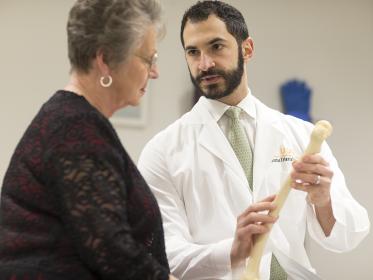Osteoporosis Risk Factors & Treatment
A risk factor is anything that increases the likelihood of someone developing a disease or injury. Learn more about osteoporosis risk factors and treatment. Those factors include the ones that you can control, as well as those factors that you can’t change.
Uncontrollable Risk Factors
A number of factors that put us at risk for developing osteoporosis are beyond our control. These factors include:
Age: Osteoporosis is more likely to affect people over the age of 50.
Gender: According to the National Osteoporosis Foundation, approximately half of all women over age 50 will suffer bone breakage related to osteoporosis. A woman’s risk of breaking a hip due to osteoporosis is equal to her risk of breast, ovarian and uterine cancer combined. Contributing factors include smaller, lighter bones, and a decrease in estrogen production after menopause.
That’s not to say men aren’t also at risk; a man age 50 or older is more likely to break a bone due to osteoporosis than he is to get prostate cancer.
Ethnicity: Women of all races are at a significant risk of developing the disease, but osteoporosis is more common in Caucasian and Asian women than in Hispanic or African-American women.
Family history: If members of your family have been diagnosed with osteoporosis, you may be at a greater risk of developing the disease yourself.
Bone structure: If you’re small-boned or thin, you’re at greater risk for osteoporosis.
Diseases and medications: Some diseases, such as lupus, rheumatoid arthritis and diabetes, are associated with a higher risk for osteoporosis. There are also a number of medications that have been linked to an increased risk. When the condition is a result of another disease or medication, it’s known as secondary osteoporosis.
Controllable Risk Factors
There are several risk factors that are lifestyle choices that you can change to decrease your risk of osteoporosis. These include:
- Smoking
- Excessive alcohol consumption
- Not getting enough calcium and vitamin D
- Not eating enough fruits and vegetables
- Consuming too much protein, sodium or caffeine
- Not getting enough exercise
Treatment and Resources
There is no cure for osteoporosis yet, but there are a number of ways to manage the disease and, in some cases, even reverse the effects. Some common treatment options include:
Medication and Treatment Options
Your doctor might prescribe medications that can help stop bone loss and even rebuild bone tissue.
Minimally invasive surgery can often correct spinal fractures by inserting an orthopedic balloon into the damaged vertebra to gently push it back into position; bone cement is then used to prevent further collapse. This procedure, called balloon kyphoplasty, has been proven to significantly decrease back pain and correct spinal damage due to osteoporosis.

